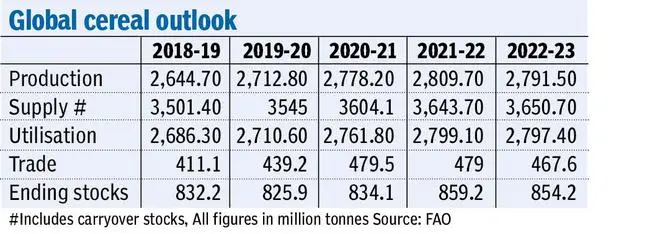Global cereals production is likely to be lower during the current 2022-23 season (July-June) with wheat and coarse cereals output being estimated lower by the Food and Agriculture Organisation (FAO) and the US Department of Agriculture (USDA).
In the case of rice, FAO and USDA have come up with contrasting outlook with the former projecting a drop and the latter a marginal rise in this season.

Forecast lowered
According to FAO, global cereal production is estimated at 2,791.5 million tonnes (mt) against 2,809.7 mt in 2021-22. The USDA has projected the output to drop to 2,763.6 mt against the preliminary estimates of 2,796.2 mt in 2021-22.
Wheat production is estimated at 770.3 mt this season against 778.3 mt last season by FAO. The USDA has pegged it at 771.6 mt (779 mt). “The forecast for world wheat production has been lowered in July to 770.3 mt, 1.0 per cent lower year-on-year. The marginally diminished outlook results from cuts to production forecasts for the European Union, where persisting dryness has impaired yield prospects, and to a lesser degree for Argentina and Iraq,” the FAO said.
Ukraine output seen down
These downgrades more than outweigh improved harvest expectations in Canada and Australia, where conducive weather at planting time and remunerative prices are encouraging area expansions, it said, adding that continued beneficial weather in the Russian Federation has lifted yield prospects of the winter crop.
The USDA said wheat production in war-torn Ukraine will be 41 per cent lower than the last season at 19.5 mt with per hectare yield dropping 17 per cent. The area under wheat in the former Soviet republic is also 29 per cent down year-on-year.
Wheat production has been estimated three per cent higher in Canada, while Russian and Kazakhstan output will likely be 8 per cent and 10 per cent more, respectively. The cereal’s production in Europe is projected three per cent lower by the US agency.
According to the FAO, global rice (milled) production this season has been projected at 520.5 mt compared with 522.5 mt last season. The USDA has pegged it at 514.8 mt (513.6 mt). While the FAO has raised its forecast by one mt from June, the USDA has cut it by 0.5 mt.
EU rice in trouble
The USDA said rice production was lower in Sri Lanka due to a drop in yield, while European Union production is forecast to decline by 16 per cent due to drought in Spain and Italy.
Lack of winter snowfall upstream in the Alps, coupled with little rainfall in the Po watershed and higher-than-normal temperatures during spring causing water shortage in the Po river have been cited as reasons by USDA for EU rice crop being affected.
World coarse cereals production is projected to decline to 1,500.7 mt (1508.8 mt) by the FAO, while the USDA estimates it at 1,477.2 mt (1503.6 mt).
Indian sowing up
“(Coarse cereals) Prospects were bolstered this month by reports indicating large maize plantings in China (mainland) and India. Furthermore, although still pointing to a likely 30 per cent decline from the past five-year average, Ukraine’s maize production prospects were also lifted with official data indicating larger-than-previously anticipated maize sowings,” the FAO said.
These increases are likely to more than outweigh moderate cutbacks to production forecasts for Mexico and several Far-East Asian countries, as well as a more sizeable cut to the forecast for the European Union, where plantings are lower than originally predicted and drier-than-normal weather has dampened yield prospects, it said.
The USDA said Kenya’s maize production may be affected due to below-average rainfall during the March-June period and high fertiliser prices affecting its applications.
The USDA also forecast global oilseeds production at seven per cent higher at 647.1 mt (600.3 mt) with a seven per cent rise in Russian sunflower and three per cent in European rapeseed output likely to make up for a four cent fall in Malaysian palm oil output.
The FAO projected an increase in supply but a drop in utilisation, trade and ending stocks. The agri commodities market reaction for the USDA outlook was mixed with prices of soyabean and rice dropping, while wheat and corn gained.








Comments
Comments have to be in English, and in full sentences. They cannot be abusive or personal. Please abide by our community guidelines for posting your comments.
We have migrated to a new commenting platform. If you are already a registered user of TheHindu Businessline and logged in, you may continue to engage with our articles. If you do not have an account please register and login to post comments. Users can access their older comments by logging into their accounts on Vuukle.